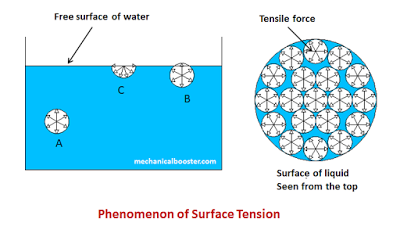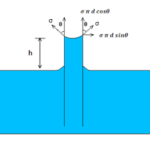Surface Tension (ST) is defined as the tensile force acting on
the free surface of liquid which is in contact with a gas or on the surface in
between two immiscible liquids such that the contact surface behaves like a
thin membrane under tension. It is more interesting to know how this tensile
force acts on the free surface of the liquid.
the free surface of liquid which is in contact with a gas or on the surface in
between two immiscible liquids such that the contact surface behaves like a
thin membrane under tension. It is more interesting to know how this tensile
force acts on the free surface of the liquid.
To understand that lets us take three molecules of liquid as
A, B and C. Molecule A is completely lie inside the free surface of liquid, it
experiences equal tensile force in all direction from its neighboring
molecules. So the net resultant force on the molecule A is zero.
A, B and C. Molecule A is completely lie inside the free surface of liquid, it
experiences equal tensile force in all direction from its neighboring
molecules. So the net resultant force on the molecule A is zero.
The molecule B is situated near the free surface of the
liquid. It is experiencing upward and downward forces. But the magnitude of the
downward force is greater than the upward force; hence it experiences a net
downward force.
liquid. It is experiencing upward and downward forces. But the magnitude of the
downward force is greater than the upward force; hence it experiences a net
downward force.
The molecule C which is situated on the free surface of the
liquid experiences a net downward force. So all the molecules of liquid which
is situated on the free surface of the liquid experiences a net downward force.
Due to this, the free surface of the liquid acts likes a thin film under
tension.
liquid experiences a net downward force. So all the molecules of liquid which
is situated on the free surface of the liquid experiences a net downward force.
Due to this, the free surface of the liquid acts likes a thin film under
tension.
Also Read: What is Viscosity in Fluid Mechanics?
Cause
Surface tension occurs due to cohesive forces existing in between the molecules of liquid. It is the cohesive forces that allows one molecule of liquid to attract its neighbouring molecules. Due to this cohesive forces the molecules of liquid on the free surface experiences a tensile force.
Formula
When the tensile force acting on the free surface of the
liquid is calculated on unit length than the quantity we get is called surface
tension. It is also equal to the surface energy per unit area.
liquid is calculated on unit length than the quantity we get is called surface
tension. It is also equal to the surface energy per unit area.
- It is denoted by the Greek letter σ
(sigma) - Its SI unit is N/m.
Mathematically,
Where
σ = Surface tension
F = Tensile force
l = length on which tensile force acts
- The ST of water in contact with air at 20 degree celsius is 0.0725 N/m. and
- The ST of mercury in contact with air at 20 degree celsius is 0.52 N/m.
Examples
- Drops of water: it is observed that the drops of
water have spherical shape and this happens due to the ST of the
water. - Insects walking on water: We have seen so many
times that small insects are capable of walking on the surface of water. This
is possible because of the ST of the water, it provides a thin
film for the insects on which they can balance their body and prevent them from
sinking. - Needle or paper clip floating on water: A needle
or paperclip is a metallic part which has more density than water. But even
after than they can float on the free surface of the water and this is due to
the surface tension.











